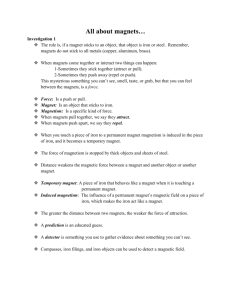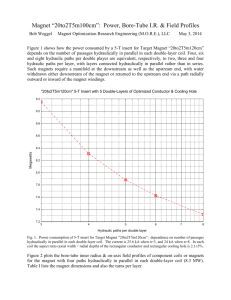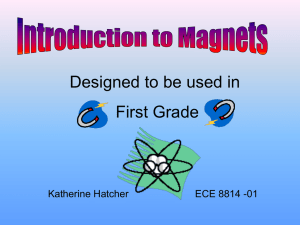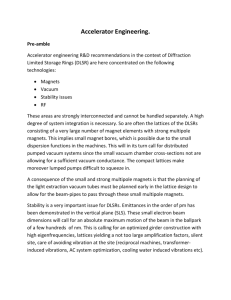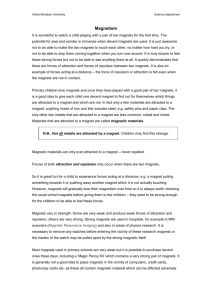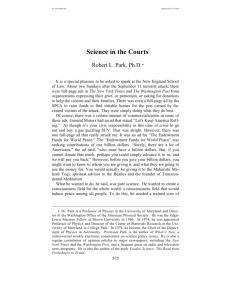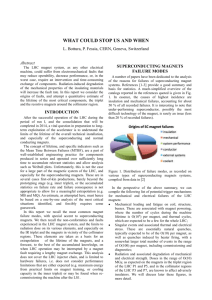Teaching Science Concepts
advertisement
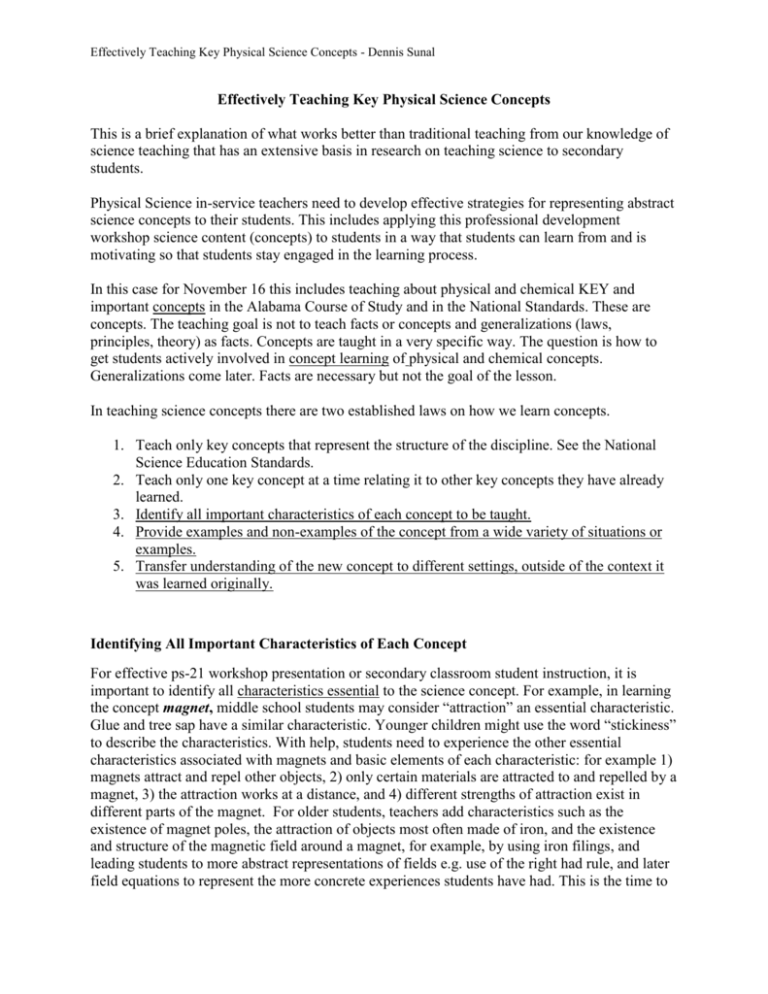
Effectively Teaching Key Physical Science Concepts - Dennis Sunal Effectively Teaching Key Physical Science Concepts This is a brief explanation of what works better than traditional teaching from our knowledge of science teaching that has an extensive basis in research on teaching science to secondary students. Physical Science in-service teachers need to develop effective strategies for representing abstract science concepts to their students. This includes applying this professional development workshop science content (concepts) to students in a way that students can learn from and is motivating so that students stay engaged in the learning process. In this case for November 16 this includes teaching about physical and chemical KEY and important concepts in the Alabama Course of Study and in the National Standards. These are concepts. The teaching goal is not to teach facts or concepts and generalizations (laws, principles, theory) as facts. Concepts are taught in a very specific way. The question is how to get students actively involved in concept learning of physical and chemical concepts. Generalizations come later. Facts are necessary but not the goal of the lesson. In teaching science concepts there are two established laws on how we learn concepts. 1. Teach only key concepts that represent the structure of the discipline. See the National Science Education Standards. 2. Teach only one key concept at a time relating it to other key concepts they have already learned. 3. Identify all important characteristics of each concept to be taught. 4. Provide examples and non-examples of the concept from a wide variety of situations or examples. 5. Transfer understanding of the new concept to different settings, outside of the context it was learned originally. Identifying All Important Characteristics of Each Concept For effective ps-21 workshop presentation or secondary classroom student instruction, it is important to identify all characteristics essential to the science concept. For example, in learning the concept magnet, middle school students may consider “attraction” an essential characteristic. Glue and tree sap have a similar characteristic. Younger children might use the word “stickiness” to describe the characteristics. With help, students need to experience the other essential characteristics associated with magnets and basic elements of each characteristic: for example 1) magnets attract and repel other objects, 2) only certain materials are attracted to and repelled by a magnet, 3) the attraction works at a distance, and 4) different strengths of attraction exist in different parts of the magnet. For older students, teachers add characteristics such as the existence of magnet poles, the attraction of objects most often made of iron, and the existence and structure of the magnetic field around a magnet, for example, by using iron filings, and leading students to more abstract representations of fields e.g. use of the right had rule, and later field equations to represent the more concrete experiences students have had. This is the time to Effectively Teaching Key Physical Science Concepts - Dennis Sunal teach a higher level concept, fields and forces. It is important to help students distinguish nonessential characteristics, also. Magnet size and shape are useful in determining some differences in attraction along the length of the magnet and the shape of the close in magnetic field, but are not essential in the overall concept. For example, a horseshoe or bar shape is not an essential characteristic of a magnet. Providing Examples and Non-Examples As concepts are formed, a sufficient number of examples and non-examples of the concept must be examined and reorganized. Examples are any and all individual items or events that have the essential characteristics of a given concept. If a class was working with the concept of magnet for instance, a teacher working with middle school students might provide factual information and use examples such as bar magnets, advertising magnets, door latch magnets, and electromagnets. Students would look and explore magnets in everyday life, media, and in science apparatus. They would explore actual magnets in their school lab inquiring about their essential characteristics. They also would use them to solve problems and build devices with them. Non-examples are any and all individual items and events that may have some but not all the essential characteristics that make items examples of a given concept. As part of the process of constructing the concept of magnet, young middle school students might examine non examples such as other metals and non-mental objects, sticky tape and other sticky materials, electrostatic attraction of objects, etc. While these have some characteristics are similar to those of a magnet, they are not similar enough to be considered as magnets. Electrostatic attraction and repulsion of objects is one non-example. The teacher plays a critical role in helping students identify the essential characteristics and examples of a science concept. The teacher, for example, could use a learning cycle with each essential characteristic of the magnet to produce conceptual change in younger middle school students. For older students, a learning cycle could involve them in testing characteristics of magnets to determine which seem essential. Transferring understanding of the new concept to different settings, outside of the context it was learned originally. Concepts are best introduced in a lesson, using a learning cycle, through exploration experiences with the concept during the Exploration phase of the learning cycle. The exploration of a concept is followed by providing its name and examples and non-examples of the concept during the Invention phase of the learning cycle. The Expansion phase of the lesson asks students to apply what they have just learned in problem settings that are different than the original context where it was just learned. This can be done either by using hands-on experiences and minds-on problems that are different or using school building applications or field trips to settings where what they just learned can be applied. Effectively Teaching Key Physical Science Concepts - Dennis Sunal Science lesson involving learning of a science concept Exploration phase: ask students to make and discuss predictions and carry out tests at learning stations for several essential characteristics. Invention phase: involve students in discussing the results of the tests of their predictions. As the discussion progresses, provide them with clear explanations of the essential characteristics and numerous examples and non-examples. The examples make obvious the essential and nonessential characteristics of the concept. Expansion phase: involve students in making further applications and in transferring their knowledge of the concept to situations outside the classroom lesson and outside of the classroom context. A setting concerning an everyday use of a magnet and a setting associated with a person on the job are appropriate. For example, ask students, “How would you retrieve a quarter that has just fallen into a sewer grating and is still visible? (Note: coins are usually not made of iron so one could not use a magnet on a string.). A job situation might involve the question, “How would you solve a tool storage problem on a manned space station? You have a box full of small tools you use frequently, but when you open the box, screwdrivers and hammers made of iron float out of it.” The following are possible active learning, student engagement methods that may be useful. Methods to choose from for a Learning Cycle sequence include: Exploration If you could have 5-10 concrete everyday examples of the concept at stations around the room and have groups move from station to station making predictions and developing an argument for their selection, then experiencing the event and explaining what they saw. Their responses should then be defended by each (or selected) small group in a whole group scientific convention or debate (scientific argumentation activity). Invention Involve the students in discussing the results of the tests of their predictions in the Exploration. This brings out their prior knowledge and “misconceptions.”As the discussion progresses, provide them with clear explanations of the essential characteristics and numerous examples and non-examples of the concept, and ask students to apply the concept in a new context, transfer. The examples make obvious the essential and nonessential characteristics of the concept. If you go beyond concept learning to generalizations and relationships, e.g. mathematical, these should be done in the next lesson. Expansion Provide 5+ concrete everyday examples (problems or events) of the concept with groups of three or four maximum. Give each group materials to carry out the concept experience, predictions and trial testing experiences. Have the groups use the internet to find out information to support their conclusion on the type of change this represents. The group then develops an argument for their selection of an explanation. Their responses should then be defended by each (or selected) small group in a whole group scientific convention or debate (scientific argumentation activity).


